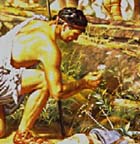 While studying first-hand sources, George Saliba, former chair of the department of Middle East and Asian Languages and Cultures at Columbia University and a researcher studying ancient scientific texts, noticed that when illustrations became so precious in themselves to historians, key sections of the texts were dismissed through the ages and went missing.
While studying first-hand sources, George Saliba, former chair of the department of Middle East and Asian Languages and Cultures at Columbia University and a researcher studying ancient scientific texts, noticed that when illustrations became so precious in themselves to historians, key sections of the texts were dismissed through the ages and went missing.
Saliba presented the case of Dioscorides' text on the Mandrake plant. Pedanius Dioscorides (40-90 AD) was a Greek physician who traveled extensively through the Roman empire while serving with the army.
During his travels, he sought medical substances from all over the Roman and Greek world. Probably between 64-77 AD, he wrote his fundamental work known in Latin as De Materia Medica (the world's first pharmacopoeia). This five-volume book became the standard reference on pharmacology for more than 1,500 years.
According to Saliba, Dioscorides' texts suffered more than others because they were so heavily illustrated. Although the original Greek manuscript was not illustrated, the versions that followed, whether in Arabic, Latin or Syriac, were. And all of them are missing a crucial part of the text.
"Indeed, if one were to leaf through an illustrated Dioscorides manuscript, and reach the part about the Mandrake plant, the reader would see an illustration of the Mandrake, which root is depicted as having the shape of a human body to convey that it has what we could call today the Viagra effect," Saliba says "or an invigorating effect.
But the Mandrake is also poisonous, and so strongly that it was used as a surgical anesthetic."
So this is where the danger of beauty lies: manuscripts' illustrations have captured so much of the attention of art historians, librarians and curators over the centuries that they were often ripped out to be framed and hung in libraries, while their texts were left in archives.
See also the history of pharmacology
No comments:
Post a Comment